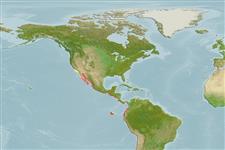Actinopterygii (ray-finned fishes) >
Clupeiformes (Herrings) >
Clupeidae (Herrings, shads, sardines, menhadens) > Dorosomatinae
Etymology: Opisthonema: Greek, opisthe = behind + Greek,nema = filament (Ref. 45335).
Environment / Climate / Range
Ecology
Marine; pelagic-neritic; depth range 0 - 50 m (Ref. 188). Subtropical, preferred ?; 36°N - 6°S, 123°W - 77°W (Ref. 188)
Eastern Pacific: Los Angeles, California to Sechura Bay, Peru. (Included in at least some accounts of Opisthonema bulleri and especially Opisthonema libertate which used to be the only Pacific species recognized).
Size / Weight / Age
Maturity: Lm ? range ? - ? cm
Max length : 30.0 cm TL male/unsexed; (Ref. 55763); common length : 20.0 cm SL male/unsexed; (Ref. 9291)
Dorsal
spines
(total): 0;
Dorsal
soft rays
(total): 13-21;
Anal
spines: 0;
Anal
soft rays: 12 - 23. Body moderately deep and compressed; posterior edge of gill openings with two clearly visible, fleshy, protuberances; gill rakers numerous, 41 to 69 on ceratobranchial (in fish longer than 14 cm total length); last dorsal ray elongated and filamentous; back gray-green with silver-white flanks and a black spot behind the gill slit followed by a yellow lateral strip (Ref. 55763). The filamentous last dorsal fin ray distinguishes it from members of any other eastern Pacific clupeoid genus. Separated from other eastern Pacific Opisthonema by having 41 to 69 lower gill rakers in fishes over 14 cm standard length.
Usually found near shore, forming schools. Feeds on crustaceans and pteropods.
Life cycle and mating behavior
Maturity | Reproduction | Spawning | Eggs | Fecundity | Larvae
Whitehead, P.J.P., 1985. FAO Species Catalogue. Vol. 7. Clupeoid fishes of the world (suborder Clupeioidei). An annotated and illustrated catalogue of the herrings, sardines, pilchards, sprats, shads, anchovies and wolf-herrings. FAO Fish. Synop. 125(7/1):1-303. Rome: FAO. (Ref. 188)
IUCN Red List Status (Ref. 115185)
CITES (Ref. 94142)
Not Evaluated
Threat to humans
Harmless
Human uses
Fisheries: minor commercial; bait: occasionally
More information
Common namesSynonymsMetabolismPredatorsEcotoxicologyReproductionMaturitySpawningFecundityEggsEgg development
ReferencesAquacultureAquaculture profileStrainsGeneticsAllele frequenciesHeritabilityDiseasesProcessingMass conversion
Tools
Special reports
Download XML
Internet sources
